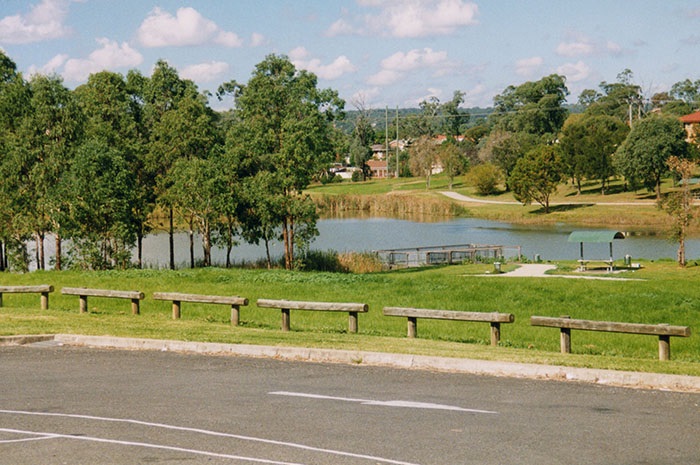History of Eagle Vale
To be locked up in chains and forcibly transported across the seas as a convict was in fact a big stroke of luck for many poor Englishmen of the early 1800's. Because after their sentences had expired, many went on to amass a level of wealth, power and land ownership thought impossible back home.
One such man was Thomas Clarkson - "founding father" of the Eagle Vale area.
Arriving at Sydney Cove under a 14-year sentence in 1806, Clarkson had won a pardon by 1811. And thanks to hard work, business acumen, and a touch of luck, he quickly prospered as both a publican and an baker.
Within two years of receiving his 100-acre (40ha) grant at the foot of what is now the Scenic Hills in 1816, Clarkson had acquired several adjoining grants. He named his enlarged property Woodland Grove an indication of the thick bushland that once covered the slopes.
It was on one of the these newly-purchased portions - 50 acres (20ha) originally granted to Mark Millington - that Clarkson built a fine brick house for himself about 1820.
By the time Clarkson died in 1826, his total estate covered almost 1400 acres (560ha) and was one of the largest farms on Campbelltown's western hills.
It was two years later that a wealthy widow called Jemima Jenkins bought the property. She was a cousin of Lord Horatio Nelson, the hero of Trafalgar, and her husband had been a founder of the Bank of NSW (later Westpac).
But she discarded the name Woodland Grove and instead gave her address as "Eagle Farm, Eagle Vale". An early map shows the property had two shallow streams - "Eagle Creek" and "Vale Brook".
Much of the waterway was replaced by flood mitigation devices in the 1980's, such as detention basins and stormwater pipes. But marking the creek's former route today is two major parks - Eagle Farm Reserve (named after the early homestead) and leafy Thomas Clarkson Reserve, which tribute to the pioneer farmer.

Eagle Farm Reserve, Emerald Drive, Eagle Vale in 2002
Dozens of convicts and servants were employed on Eagle Vale by Jemima Jenkins, tending crops and looking after hundreds of sheep, cattle and horses.
At a time when few women owned real estate, she seems to have been an unusually independent and liberated lady, actively lobbying for improved roads, schools and churches.
Robert Pitt Jenkins, MLC, inherited Eagle Vale on his mother's death in 1842, yet he and his young family were drowned in a shipwreck shortly after selling the estate in 1858.
The purchaser was William Fowler, a Campbelltown storekeeper and postmaster, and the property was renamed again - this time to Eschol Park. As the decades rolled on, the Eagle Vale name became largely unused and forgotten.
It was only in the mid 1970's - when a host of new suburbs were being planned for Campbelltown's western hills - that the old name was resurrected by Council. The suggestion met wide support and in 1976 "Eagle Vale" was approved by the geographical Names Board. The suburb name is definitely two words, even though some early residents, maps and press reports spelt it "Eaglevale".
Landcom purchased much of the land and in December 1978 it announced the first 290 lots would soon be released. When they finally became available in the early 1980's, they were mostly snapped up by young couples buying their first home.
A major road connecting Raby Road and Badgally Road was built in 1980-81 and called Eagle Vale Drive. Today it forms the official suburb border with neighbouring Eschol Park.
But the street being built in Eagle Vale itself still needed to be named. So in October 1980, the Council approved a theme of "minerals and gemstones".
Some of the mineral names which can now be spotted on street signs include: Malachite, Zeolite, Peat, Alabaster, Bauxite, Calcite, Lodestone, Cinnabar, Clay, Feldspar, Quartz, Saltpetre, Serpentine, Fluorite, Galena, Gypsum, Talc, Pyrite, Mica, Lignite and Silica.
Some of the gemstones are: Aquamarine, Onyx, Jade, Diamond, topaz, Sapphire, Moonstone, Cameo, Peridot, Agate, Turquoise, Amethyst, Amber and Opal. The suburbs main thoroughfare is Emerald Drive.
But what type of minerals or gemstones were honoured by Namatjira Close, Power Close and Ashton Close? The answer is simple. None!
These streets actually recall famous Aboriginal artist, Albert Namatjira, the Australian War artist, Septimus Power, and founder of Adelaide's Academy of the Arts, James Ashton.
Some adjoining street also note artist as famous as Lloyd Rees, William Dargie, Oswald Brierley, Albert Newbury and Frank Crozier. These names reveal the fact that this south-western part of Eagle Vale was actually once part of Claymore (which uses "great Australian artists" as its street names).
The area was developed as a private subdivision, but by 1986 residents angrily claimed their "image" and land values were suffering as they were considered to be part of Claymore's Housing Commission estate. After two years lobbying, the Council finally agreed to move the suburb boundary, bringing the streets into Eagle Vale.
Major housing estates have continued well into the mid-1990's, one of the most recent being the Eagle Ridge Estate near Raby Road.
Eagle Vale High School was built in 1984, while St Mary Immaculate Catholic Primary School was officially opened in 1986.
Campbelltown's most modern swimming facilities came to the suburb in 1993, with the opening of Eagle Vale Leisure Centre off Emerald Drive. The district shopping centre was under construction as this book was being written.
"Campbelltown's Streets and Suburbs - How and why they got their names" written by Jeff McGill, Verlie Fowler and Keith Richardson, 1995, published by Campbelltown and Airds Historical Society.
Reproduced with permission of the authors.